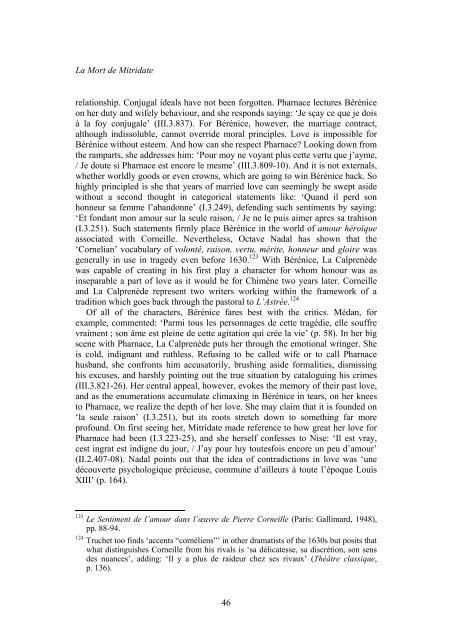LA MORT DE MITRIDATE - University of Liverpool
LA MORT DE MITRIDATE - University of Liverpool
LA MORT DE MITRIDATE - University of Liverpool
You also want an ePaper? Increase the reach of your titles
YUMPU automatically turns print PDFs into web optimized ePapers that Google loves.
La Mort de Mitridate<br />
relationship. Conjugal ideals have not been forgotten. Pharnace lectures Bérénice<br />
on her duty and wifely behaviour, and she responds saying: ‘Je sçay ce que je dois<br />
à la foy conjugale’ (III.3.837). For Bérénice, however, the marriage contract,<br />
although indissoluble, cannot override moral principles. Love is impossible for<br />
Bérénice without esteem. And how can she respect Pharnace? Looking down from<br />
the ramparts, she addresses him: ‘Pour moy ne voyant plus cette vertu que j’ayme,<br />
/ Je doute si Pharnace est encore le mesme’ (III.3.809-10). And it is not externals,<br />
whether worldly goods or even crowns, which are going to win Bérénice back. So<br />
highly principled is she that years <strong>of</strong> married love can seemingly be swept aside<br />
without a second thought in categorical statements like: ‘Quand il perd son<br />
honneur sa femme l’abandonne’ (I.3.249), defending such sentiments by saying:<br />
‘Et fondant mon amour sur la seule raison, / Je ne le puis aimer apres sa trahison<br />
(I.3.251). Such statements firmly place Bérénice in the world <strong>of</strong> amour héroïque<br />
associated with Corneille. Nevertheless, Octave Nadal has shown that the<br />
‘Cornelian’ vocabulary <strong>of</strong> volonté, raison, vertu, mérite, honneur and gloire was<br />
generally in use in tragedy even before 1630. 123 With Bérénice, La Calprenède<br />
was capable <strong>of</strong> creating in his first play a character for whom honour was as<br />
inseparable a part <strong>of</strong> love as it would be for Chimène two years later. Corneille<br />
and La Calprenède represent two writers working within the framework <strong>of</strong> a<br />
tradition which goes back through the pastoral to L’Astrée. 124<br />
Of all <strong>of</strong> the characters, Bérénice fares best with the critics. Médan, for<br />
example, commented: ‘Parmi tous les personnages de cette tragédie, elle souffre<br />
vraiment ; son âme est pleine de cette agitation qui crée la vie’ (p. 58). In her big<br />
scene with Pharnace, La Calprenède puts her through the emotional wringer. She<br />
is cold, indignant and ruthless. Refusing to be called wife or to call Pharnace<br />
husband, she confronts him accusatorily, brushing aside formalities, dismissing<br />
his excuses, and harshly pointing out the true situation by cataloguing his crimes<br />
(III.3.821-26). Her central appeal, however, evokes the memory <strong>of</strong> their past love,<br />
and as the enumerations accumulate climaxing in Bérénice in tears, on her knees<br />
to Pharnace, we realize the depth <strong>of</strong> her love. She may claim that it is founded on<br />
‘la seule raison’ (I.3.251), but its roots stretch down to something far more<br />
pr<strong>of</strong>ound. On first seeing her, Mitridate made reference to how great her love for<br />
Pharnace had been (I.3.223-25), and she herself confesses to Nise: ‘Il est vray,<br />
cest ingrat est indigne du jour, / J’ay pour luy toutesfois encore un peu d’amour’<br />
(II.2.407-08). Nadal points out that the idea <strong>of</strong> contradictions in love was ‘une<br />
découverte psychologique précieuse, commune d’ailleurs à toute l’époque Louis<br />
XIII’ (p. 164).<br />
123 Le Sentiment de l’amour dans l’œuvre de Pierre Corneille (Paris: Gallimard, 1948),<br />
pp. 88-94.<br />
124 Truchet too finds ‘accents “cornéliens”’ in other dramatists <strong>of</strong> the 1630s but posits that<br />
what distinguishes Corneille from his rivals is ‘sa délicatesse, sa discrétion, son sens<br />
des nuances’, adding: ‘Il y a plus de raideur chez ses rivaux’ (Théâtre classique,<br />
p. 136).<br />
46
















